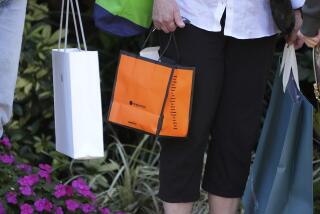Summer retail sales rise but spending may not hold up through holidays
As back-to-school sales blur into Christmas layaway promotions, consumers are spending again — but some economists warn that the splurging may be fleeting.
Americans opened their wallets in August after falling gas prices and an improving job market boosted their confidence.
U.S. retail sales jumped 0.6% last month from July, the biggest increase in four months, the Commerce Department said Friday. Economists had expected an increase of 0.5%, according to FactSet.
In another show of strength, July sales were revised to a gain of 0.3% from June, up from a previous estimate that spending was flat.
“Consumers came back with a vengeance in August,” said Chris Christopher, an economist at IHS Global Insight. “Retail sales were driven by a strong need to buy automobiles, falling pump prices, rising consumer confidence and stronger-than-expected back-to-school sales.”
Although the healthy showing soothed worries that consumers had held back over the summer, some analysts cautioned that people were unlikely to give the economy a big boost during the holidays with heavy spending.
“The consumer is still under pressure against the backdrop of minimal income growth,” said Lindsey Piegza, chief economist at Sterne Agee. “If the consumer is not happy and healthy and spending, it means the economy overall is in trouble.”
Other economists were more optimistic.
The holiday season “is expected to glitter in comparison to the last two years,” Christopher said. He said last winter set a particularly low bar of comparison, with the government shutdown and harsh weather in many parts of the country discouraging people from shopping.
Stripping away motor vehicle and parts receipts, retail sales increased 0.3%. Total retail sales were up 5% from August 2013, the biggest growth in more than a year.
Several sectors showed growth in August. Clothing and accessories store sales had a 0.3% rise. Furniture sales grew 0.7%, and building materials and supplies dealers reported a 1.4% increase.
The uptick in spending last month was mainly driven by consumers who were enjoying declining prices at the pump, observers said. Although the back-to-school season is no longer the big shopping event it once was, those who saved money on gas headed to the malls.
“Back-to-school shopping had a very positive influence on traffic,” according to a report from Euclid, which analyzes shopping patterns. “Traffic continued to rise even through the end of the month as favorable weather and soaring consumer confidence added to the positive momentum.”
Euclid said store traffic climbed 7% in August over the month before, but it actually fell 3.1% compared with the same month a year earlier.
Retail sales are considered a bellwether of consumer spending, which makes up two-thirds of U.S. economic activity. Healthy spending in July and August, when combined with other indicators showing economic growth, could boost expectations of higher spending during the holidays.
Consumer confidence hit a 14-month high in early September, according to the Thomson Reuters/University of Michigan index. The Institute for Supply Management recently said the pace of growth in August in the U.S. services sector was the best since 2008. The jobless rate fell to 6.1% last month.
This week, both Goldman Sachs and J.P. Morgan Chase raised their estimates for gross domestic product growth in the second quarter to an annualized rate of 4.7%; J.P. Morgan Chase’s previous estimate was for 4.5% growth while Goldman’s was 4.2%.
But there is some feeling that rising consumer confidence and overall economic improvement may not translate into higher spending during the last few months of the year.
“Five years into the recovery, everyone is sick of saying how bad things are,” Piegza said. “But there is a juxtaposition of what consumers are saying and what they are doing in reality.”
She forecasted GDP to grow only a modest 2% in the second half of 2014.
Conflict in other parts of the world and stalled growth in the Eurozone in the second quarter add to uncertainty about future consumer spending, analysts said.
“The economy is moving in the right direction, but other factors, including rising concerns over the uncertainty in the Middle East, may produce some drag,” Jack Kleinhenz, chief economist at the National Retail Federation, said in a statement.
He echoed what many experts concluded after watching tepid retail sales for much of this year.
“Until the pace of income picks up,” he said, “we should not expect a sustained surge in spending.”
Twitter: @ByShanLi







